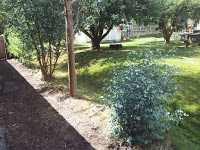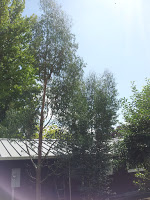

| Online: | |
| Visits: | |
| Stories: |

| Story Views | |
| Now: | |
| Last Hour: | |
| Last 24 Hours: | |
| Total: | |
Coppice Story 2.1
Here's an update on my little coppice. If you haven't read my earlier posts about coppicing, you can take a look at what it looked like in June two years ago, and if you're completely unfamiliar with coppicing or want a refresher, be sure to see the link in the post Coppice Story 2.0.
 |
| *pictures are clearer when you click on them |
This is what the coppice looks like today. The tree that winter-killed two years ago is the multi-trunked one that is third one back. That represents only two years' growth, and I'm figuring in two more years, each trunk will be the size of the one in the middle and will be ready for harvesting. In terms of short rotation, that's a phenomenal rate; most short rotation coppices are on a six year rotation, and that's for softer woods, like poplar and willow, which are grown for biomass.
The little guy in the front is the result of cutting down a second tree this past late winter. Next spring I'll have to tie up all the saplings that are a result of late winter cutting, and at the same time we'll cut down the middle tree and harvest its wood, setting it up to coppice.
To the left left here is a comparison of a four-year-old Eucalyptus with the two-year-old coppiced Eucalyptus. This particular variety is Eucalyptus gunnii, or cider gum, and is purported to be able to handle winter temperatures down to -14C or roughly 7F. Eucalyptus trees have extremely hard wood; they make terrific firewood. Every homestead needs a woodlot, and coppicing allows you to get more wood from the same space, from only one investment of time and money for planting the trees. I don't expect to get a large proportion of my burn needs from this coppice, because it's pretty small, but it's great practice for when we do have a property someday.
At least, that's the plan, anyway.
Source: http://weedingforgodot.blogspot.com/2016/09/coppice-story-21.html



